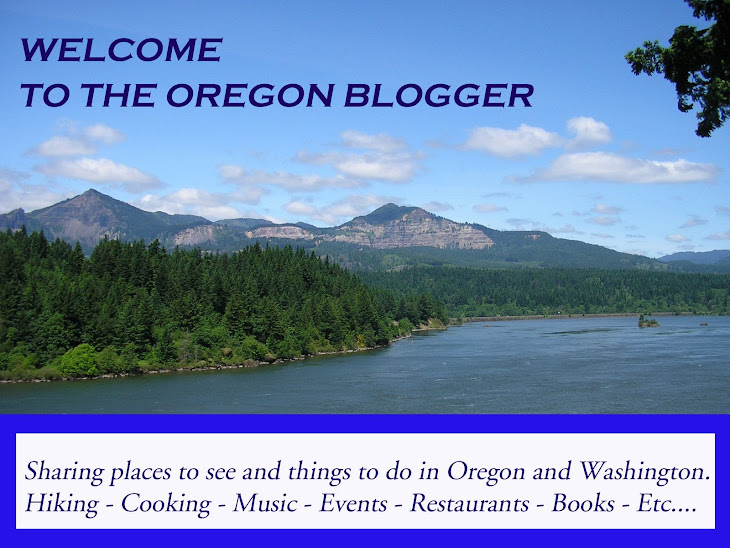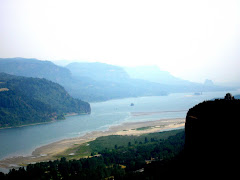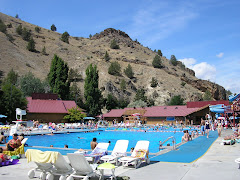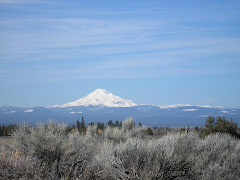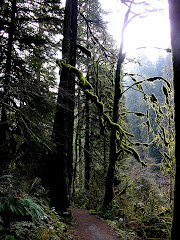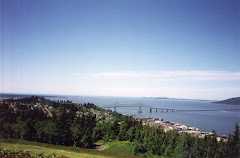OREGON AND WASHINGTON GUIDE
To see the Oregon and Washington Guide scroll down the page below oldest post, for places to see and things to do in OREGON and WASHINGTON.
 Multnomah Falls is Oregon's tallest waterfall and it's also the second tallest year-round waterfall in the United States. While at its best during winter and spring, this magnificent sight is spectacular to see any time of year.
Multnomah Falls is Oregon's tallest waterfall and it's also the second tallest year-round waterfall in the United States. While at its best during winter and spring, this magnificent sight is spectacular to see any time of year.
Fed by the crystal clear water of underground springs originating in Larch Mountain, Multnomah Falls divides into two distinct sections as it crashes to the ground. The much taller upper falls is thinner and longer while the lower section is wider and stronger. There is a fairly easy, short hiking trail up to Benson Bridge. In 1914, Simon Benson, then owner of the falls, replaced the existing log bridge with this much wider and safer bridge, crafted by Italian stone masons. Whether looking upward to the top of the falls, or downward over the lower half of the falls visitors can thoroughly enjoy great views of the Columbia River and of the falls themselves. For the more adventuresome visitor, there is a hiking trail to the top of the waterfall. This hike is long and strenuous. It's a mile long and is made up strictly of several switchbacks heading upwards at a forty-five degree angle most of the way. There are several resting points, and the view at the top is very much worth the effort.  Hiking Tips: When you start out from the parking area, you'll pass a historic 1925 stone lodge, a good place to pick up a map or a quick ice cream cone. Walk to the left of the lodge, straight toward the falls to find the paved trail switchbacking up to a stone bridge between the two segments of Multnomah Falls' long cascade.The classic hike here follows a paved 1.1-mile path to the top of the falls. But you can beat the crowds and see half a dozen extra waterfalls if you have the energy for a longer loop to Wahkeena Falls.
Hiking Tips: When you start out from the parking area, you'll pass a historic 1925 stone lodge, a good place to pick up a map or a quick ice cream cone. Walk to the left of the lodge, straight toward the falls to find the paved trail switchbacking up to a stone bridge between the two segments of Multnomah Falls' long cascade.The classic hike here follows a paved 1.1-mile path to the top of the falls. But you can beat the crowds and see half a dozen extra waterfalls if you have the energy for a longer loop to Wahkeena Falls.
 Development of Fort Vancouver by the Hudson’s Bay Company from 1825 through 1846 was a seminal event in the history of the Pacific Northwest and lower Columbia River basin. The fort was an outpost of Western civilization during that period and functioned as a commerce and provisionary center for the lucrative fur trade throughout the Pacific Northwest. It was named in honor of the famous British sea explorer, Captain George Vancouver. Under the leadership of Dr. John McLoughlin, the Hudson’s Bay Company at Fort Vancouver played a central role in the European settlement of the Pacific Northwest. As the anchor to British claims in the Pacific Northwest, Fort Vancouver was at the center of competing interests between Great Britain and the United States. With Fort Vancouver as its regional headquarters, the Hudson's Bay Company controlled 34 forts and posts in a territory encompassing present-day British Columbia, Washington, Oregon, Idaho, western Montana and the Hawaiian Islands.An 1835 visitor to the fort described it as "the New York of the Pacific."Owing to its national significance, the site was designated a National Historic Monument by Congress on June 19, 1948. In 1961, its size was expanded and renamed Fort Vancouver National Historic Site.
Development of Fort Vancouver by the Hudson’s Bay Company from 1825 through 1846 was a seminal event in the history of the Pacific Northwest and lower Columbia River basin. The fort was an outpost of Western civilization during that period and functioned as a commerce and provisionary center for the lucrative fur trade throughout the Pacific Northwest. It was named in honor of the famous British sea explorer, Captain George Vancouver. Under the leadership of Dr. John McLoughlin, the Hudson’s Bay Company at Fort Vancouver played a central role in the European settlement of the Pacific Northwest. As the anchor to British claims in the Pacific Northwest, Fort Vancouver was at the center of competing interests between Great Britain and the United States. With Fort Vancouver as its regional headquarters, the Hudson's Bay Company controlled 34 forts and posts in a territory encompassing present-day British Columbia, Washington, Oregon, Idaho, western Montana and the Hawaiian Islands.An 1835 visitor to the fort described it as "the New York of the Pacific."Owing to its national significance, the site was designated a National Historic Monument by Congress on June 19, 1948. In 1961, its size was expanded and renamed Fort Vancouver National Historic Site.
 Extensive archaeological documentation of the Fort Vancouver site from the 1940s to the present has provided a significant body of information for the interpretation and reconstruction of Fort Vancouver and its environs. Buildings reconstructed to date include the Chief Factor's House, bakery, blacksmith shop, central stores and fur storage facility. The site continues to yield important archaeological information concerning early nineteenth century patterns, events, processes, design and construction methods. Fort Vancouver National Historic Site is administered by the National Park Service.
Extensive archaeological documentation of the Fort Vancouver site from the 1940s to the present has provided a significant body of information for the interpretation and reconstruction of Fort Vancouver and its environs. Buildings reconstructed to date include the Chief Factor's House, bakery, blacksmith shop, central stores and fur storage facility. The site continues to yield important archaeological information concerning early nineteenth century patterns, events, processes, design and construction methods. Fort Vancouver National Historic Site is administered by the National Park Service.
The world is moving so fast these days that the man who says it can't be done is generally interrupted by someone doing it.
- HARRY EMERSON FOSDICK
 Multnomah Falls is Oregon's tallest waterfall and it's also the second tallest year-round waterfall in the United States. While at its best during winter and spring, this magnificent sight is spectacular to see any time of year.
Multnomah Falls is Oregon's tallest waterfall and it's also the second tallest year-round waterfall in the United States. While at its best during winter and spring, this magnificent sight is spectacular to see any time of year. Hiking Tips: When you start out from the parking area, you'll pass a historic 1925 stone lodge, a good place to pick up a map or a quick ice cream cone. Walk to the left of the lodge, straight toward the falls to find the paved trail switchbacking up to a stone bridge between the two segments of Multnomah Falls' long cascade.
Hiking Tips: When you start out from the parking area, you'll pass a historic 1925 stone lodge, a good place to pick up a map or a quick ice cream cone. Walk to the left of the lodge, straight toward the falls to find the paved trail switchbacking up to a stone bridge between the two segments of Multnomah Falls' long cascade.